Forum Replies Created
-
AuthorPosts
-
in reply to: Shoulder Shots 2 #34313
Mark, I’ll be looking forward to seeing some reports posted (and photos … please) on the results you get on pigs and elk with your setup!
Steve, I too try to watch leg position but when my arrow arrives the animal’s leg is rarely in the same position it was when I shot! That happened just as often when I hunted with compounds as it does with my longbows … and perhaps more often. The longbow is slower, but a lot more silent than any of the compounds I’ve ever shot – and both sound and the animals reaction time are far faster than an arrow from either!
Ed
in reply to: Time to increase EFOC #33720513 grains up front. That’s how! Let us know how your duel weight tubes work out, Chris.
32.7% FOC. That’s impressive,Richie. The higher I get into Ultra-EFOC the more impresses with what it does for both arrow flight and penetration.I don’t think there is an upper limit for FOC benefits.
Ed
in reply to: Enough for Elk?????? #33565I can’t really add anything to what Dave said. Can it be done? Most assuredly. But, as Dave has already stated, the lighter your bow becomes the more critical it becomes that you take every possible step to increase the arrow’s penetration potential. Among a host of other factors that means using an arrow mass above the heavy bone Threshold (approximately 650 grains). With a light bow that limits your trajectory. How much of a problem that is depends entirely on you.
If you are physically capable of using a heavier bow, then I would encurage you to do so. I’ve never heard a big game bowhunter complain that his arrow penetrated too much … and I’ve never heard one say, “I wish I’d used a lighter draw weight bow.”
Ed
in reply to: Time to increase EFOC #33555Chris, you didn’t mention the type and draw weight of your bow. Other factors, such as degree of center shot, also will affect the shaft you’ll need – or how much you’ll be able to front load the shafts you have. It’s all trial and error right now. Just start adding point weight and checking the dynamic spine with some bare shaft testing to see how much weight you can get away with adding.
You’ll want to get to at least 19% FOC if you want to see some really measurable penetration gains.
Ed
in reply to: Shoulder Shots 2 #33551Well, judging from things I have read some places we should have started at ground zero. Some folks don’t even know what a “shoulder” is. They think ‘shoulder” means the scapula, or the ball joint where the scapula and humerus articulate.
“Shoulder” is a collective anatomical term. It refers to an anatomical region (section) of the body; just as “hip” or “leg” does. The term “shoulder” includes all the tissues – meat, connective tissues and bone – contained in that anatomical region of the body.
The same terms are used in meat processing to refer to the same sections of the carcass. Here are some examples.
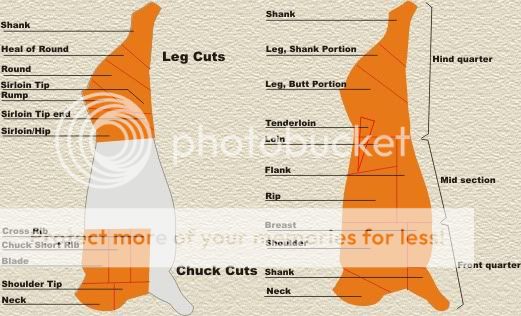

Here’s a processing chart for deer. The same entire region is correctly referred to as the “shoulder”. Note what constitutes the ‘shoulder’ region (section) of the body. It does not change from aminal to animal.
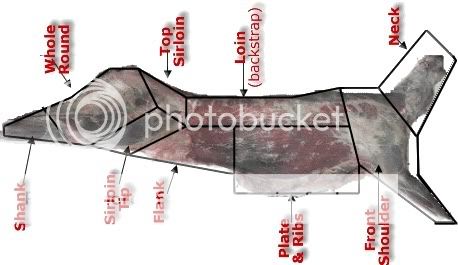
Now, if one is aiming ‘behind the shoulder” the aiming point would be where the white dot appears on the chart below. This is where every bowhunter education class I’ve ever attended (in the States) indicated as proper ‘behind the shoulder” shot placement.
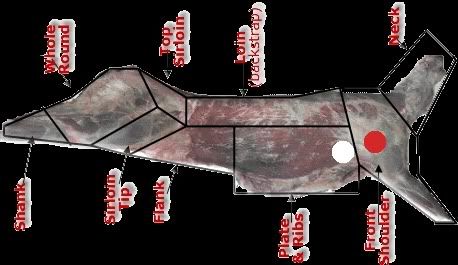
When I speak of “aiming on the shoulder” I’m refering to an aiming point corresponding to the red dot on the chart above.
Here we have a deer standing broadside.
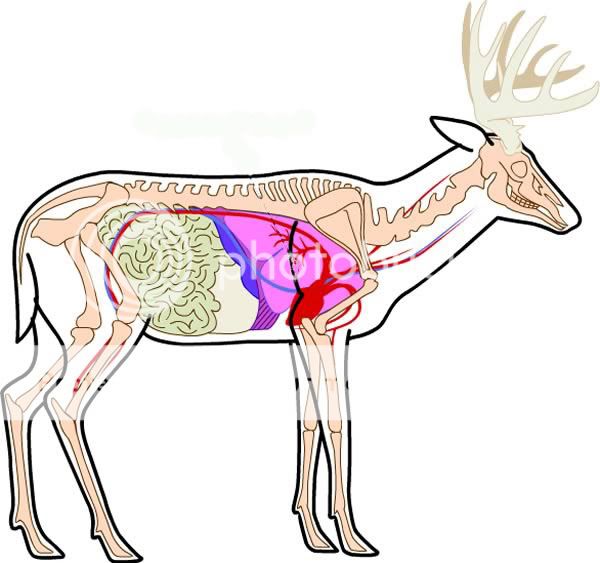
If you aim “back of the shoulder” the following will be your aiming point.
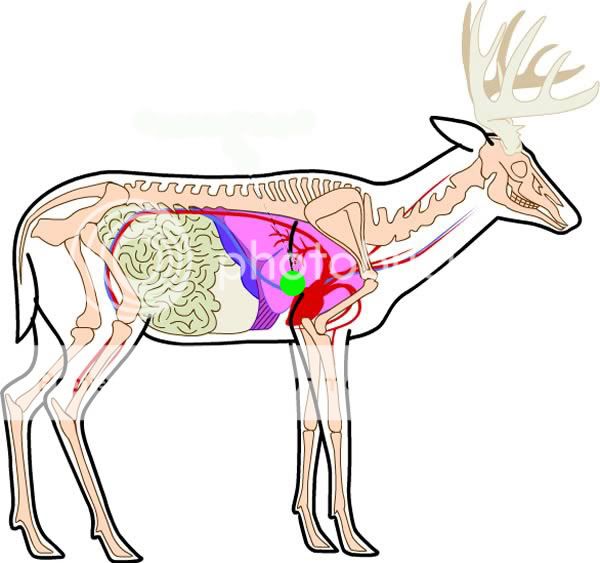
With an aiming point ‘back of the shoulder” this next diagram shows the size of the kill zone, before it first reaches a limiting edge of the thorax/liver area. Now think of the first movements a deer generally makes when it tries to “jumps the string”. It moves down and forward or down while turning either right or left. Think of where the deer’s body will be moving in relation to your kill zone. Use of this ‘back of the shoulder” aiming point is the major cause of hit too far back.
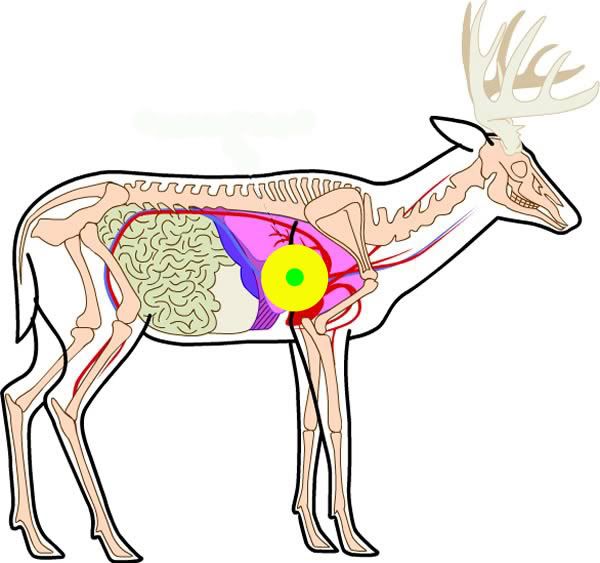
Using a ‘commonly used’ arrow setup, if you aim “on the shoulder” the following diagram shows the size of the kill zone, before it first reaches a limiting edge of the thorax/liver area. It represents a big gain over the ‘behind the shoulder” aim, and allows greater compensation for the animal’s potential movements when the shot is taken.
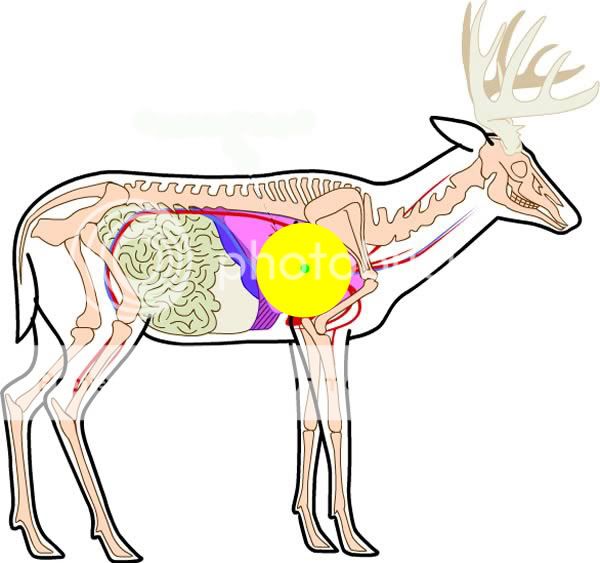
If you are using a penetration enhanced EFOC/Ultra-EFOC arrow setup having a mass weight above the heavy bone threshold the follow diagram shows the size of your effective kill zone with an ‘on the shoulder” aim. Because this type of arrow setup gives an ultra-high probability of penetrating any bone, or even any combination of bones, found in the ‘shoulder’ of a deer sized animal your kill zone is greatly expanded.
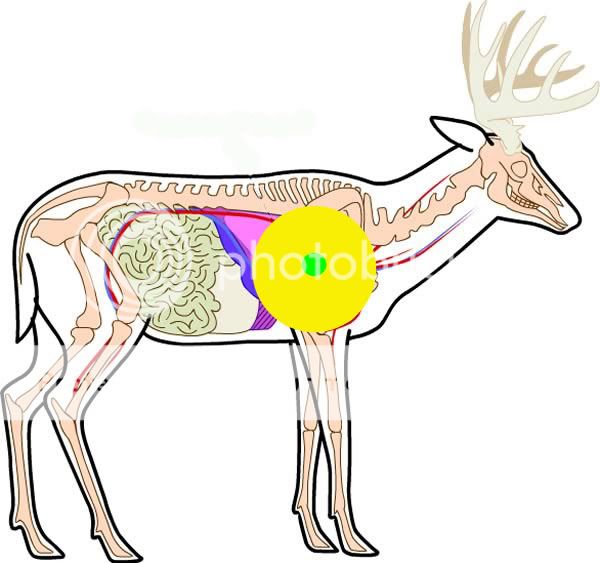
As shown, whether you are using a penetration enhanced arrow or not, the “on the shoulder” aim offers a greater zill zone than when you aim “back of the shoulder”.
Using an arrow setup that gives you the very highest chance of penetrating heavy bone offers other advantages, the above photos are all of deer standing broadside; which is not the most common shooting angle(s). Furthermore, the scapula is not always positioned as shown in the above diagrams. It moves as the position of the leg moves. That’s very likely where the advice to ‘aim behind the shoulder” originated. Here’s a diabram showing how the scapula moves as leg position changes. This particular diagram shows a bear, but the arc of movement of a deer’s scapula is virtually identical.

On some animals, sich as members of the swine and antelope families an aim ‘back of the shoulder” places you arrow extremely near the diaphram, giving an almost non-existant kill zone. Even with an ‘on the shoulder’ aim your kill zone will be small when using most ‘commonly used’ arrow setups, before the first limiting edge of the thorax/liver or heavy bones of the shoulder are reached. The following shows a ‘commonly used’ arrow’s kill zone with a “on the shoulder” aim on a pig.
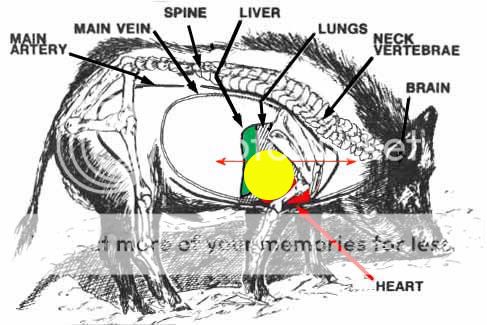
Here’s what the kill zone looks like when you’re using a penetration enhanced EFOC/Ultra-EFOC arrow setup having a mass weight above the heavy bone threshold; a setup that is capable of reliably penetrating the heavy bones of a pig’s shoulder.
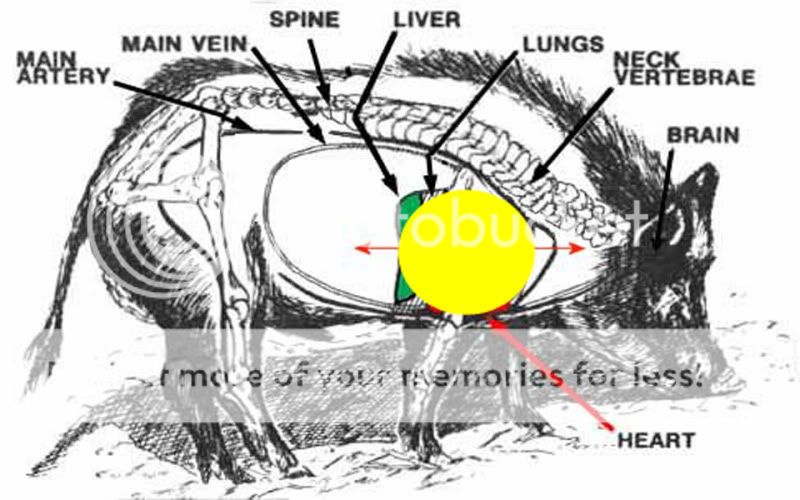
The “on the shoulder” aim’s location is best described as coming straight up from the leg to a point approximately 1/3 of the way up from the lower chest line.
Okay, now we have a common starting place for any discuaaion.
Ed
in reply to: Shoulder Shots 2 #33020Sadly, its more tragic than hilarious :cry:, but it is the reality.
It’s interesting that the 2 earliest bowhunted whitetail wound-loss rate studies I can locate, one from the 1950’s and one the early 1970’s, show a significantly lower wound-loss rate than any of the more recent srudies … even the Ripley study. What has changed so drastically between those early studies and the more recent studies? The setup of the arrows commonly used. During the period of those early studies virtually all (if not ALL) broadheads were of a rigid design. The broadheads most commonly employed were either of a 2 or a 4 blade design. Although a few hunted with 3 blade broadheads (which have far more difficulty on bone hits than either a 2 or 4 blade broadhead) most did not; at least not among the 120 or so bowhunters I hunted with on that first bowhunting-only lease in Texas. (That first bowhunting-only lease was at Wheelock, Texas, and was organized by Bob Lee.) Though there were synthetic shafts they were not of fly-weight design. They were heavy (24SRTX) aluminums, Miocroflites and massively heavy fiberglass shafts from Shakespear and others.
While those early wound-loss rates are way higher than what I’ve achieved with what the Study indicates to be the mosrt effective arrow setup it is also way lower than that of the newer studies. The connection is blatently clear, but ears deafened by media hype do not hear and eyes clouded by too much time staring at the Outdoor Channel do not see.
Ed
in reply to: Shoulder Shots 2 #32628Dave, your analysis is, as usual, very good. The crux of the problem lies with the game department allowing the uneducated public to use a light draw bow while not specifying what type of arrow setup they can and cannot use with it. Between the bow and the arrow, I’d far rather see them regulate minimum arrow standards! If they had minimum arrow weight/arrow setup standards it would deter a lot of folks from using such light draw weight bows, and those who did would at least be using a more adequate arrow.
Richie, I think you are right. I see many touting the ethics of this or that while ignoring that EVERY (non-industry funded) study of bowhunted whitetails done in the last 4 decades has shown a near identical one-to-one wound-loss ratio. Each of those studies has been by either a state game department or a university sponsored program.
Many are quick to promote the industry funded Camp Ripley Study [the one and only study in the last 4 decades that shows a significantly different (lower) wound-loss rate for whitetails – 17%, if I remember correctly; still more than double the average wound-loss rate for firearms]. It’s not comparable. The other studies consider wound-loss to mean hit and not recovered. In the Ripley Study, if the hit deer was not later found dead (actually located by human searchers) it was assumed the deer recovered from the shot and, thusly, was not a “lost” animal.
However, I personally find even the Ripley Study’s skewed wound-loss rate unacceptably high. My experience with both firearms hunted game and bowhunted game indicates that truly sharp broadheads on a good arrow setup are more lethal than bullets; when all type hits are considered; and they yield a lower wound-loss rate. My own wound-loss rate is lower for arrows than rifle hunted game. Under no circumstances should bowhunting’s whitetail wound-loss rate be higher than for firearms.
Why are none of those folks who consider a shoulder shot totally unethical (and have no experience at all with arrow setup capable of rendering them so, by being able to deal with the heavy bones, SHOULD THEY BE HIT) showing any concern about doing something to reduce what IS causing causing unnecessary wounding of game? Or do they, perhaps, think that that bowhuntings current wound-loss rate is acceptable? That it all is merely the result of ‘bad hits’? Something totally unpreventable?
Ed
in reply to: Shoulder Shots 2 #32294“I have to admit, the 35 lb limit scares me less than the 200-300 gr arrow.”
Me too! Having seen what can be done with a 40# recurve on an Asian Buffalo, draw weight isn’t the real problem – the problem is the arrow used. The down side of allowing such light draw weight bows is that MOST folks using them are going to use some dainty, fly weight arrow from it – and with about as poor a broadhead choice as they could possibly make. However, there are also a lot of folks using sub-400 grain arrows from heavier bows too and, when bone is hit, those arrows aren’t going to work much better than they would from a 35# bow!
I’ve got several photos of buffalo test shots with low mass arrows and poor broadheads shot from heavy compounds generating just shy of 95 foot-pounds of KE. After they hit and failed to even stick in the rib, the arrows are hanging down like a picador’s lance; held in only by the on-side skin.
Ed
in reply to: Shoulder Shots 2 #32167David, as usual, you have made a ‘spot on’ analysis of the situation. The famous Africa hunter/explorer, Fredrick Courtney Selous killed virtually every species of big game animal in all of southern Africa with muzzle loading and/or cartridge-firing black powder rifles, but he lived and hunted will into the somkeless powder era. After finally giving up his ponderous black powder rifles and actually trying one of the ‘newfangled’ smokeless cartridge of much smaller caliber than his huge, black powder shoulder cannons he commented, “Had I had this during whole career I would have killed thrice the number of animals!”.
Some folks are slow to change but, also, someone – some group of individulas – has to be the vanguard. You, David, are right at the forefront of the vanguard. Your great pictures often say more than I can express in 10,000 words!
Thank you.,
Edin reply to: Shoulder Shots 2 #32133Let me second what Dave just said. The move was only so that discussion of this topic can be carried forward. Forget what is elsewhere. This is an important topic that is directed towards helping reduce the wound-loss rate. That, and nothing more. Let up merely pick up where we were and move forward.
Ed
in reply to: Shoulder Shots 2 #32128Michael, In the long run you’ll save a lot by just going to carbons for EFOC arrows. You are right about tapering – to a degree. You’ll never get enough weight forward on a self-wood arrow by using just tapering, but it can provide a significant boost to a footed wood shaft that already has a high mass footing and a low mass rear shaft.
Great photos! I knew David wouldn’t be afraid of shoulders – or shoulder bones. He’s been chunking ‘penetration enhanced EFOC arrows’ at game long enough to know. If you shoot enough game you ARE going to encounter heavy bone sooner or later. Once you see what such an arrow setup does to heavy bone you don’t need much more convincing!
Now, nothing is ever infallible (except the predictability of taxes and the Government’s inefficiency and waste thereof), and there will undoubtedly be times when Murphy will intervene to cause a failure of a ‘structurally secure, penetration enhanced EFOC arrow with a mass above the Heavy Bone Threshold’ to penetrate a heavy bone, but all the data shows that it will be a VERY, VERY RARE occurrence – far, far from the norm.
I think – no, there’s enough data now – I KNOW that using better arrow setups AND moving our aiming point onto the shoulder will reduce the wound-loss rate. It will reduce the number of hits too far back. With a ‘penetration enhanced EFOC arrow having a mass above the Heavy Bone Threshold’ and aiming ‘on the shoulder’ the penetration of any heavy bone encountered on a deer-sized animal is going to be a FAR, FAR rarer occurrence than is hitting an animal too far back when using a ‘back of the shoulder’ aiming point. The wound-loss with such arrows and such shots will be less than the wound-loss rate for animals hit too far back and not recovered – even if the too-far-back hit was with a meat cleaver sized broadhead with a zillion blades.
Ed
in reply to: Shoulder Shots 2 #31490Michael, without question, the easiest shaft to use when building EFOC arrows are the carbons. I also had poor results with aluminum. On wood it becomes difficult to get really high FOC. You either have to add A LOT of weight up front or go to a footed shaft having a rear shaft of very, very light wood.
Carbons are the easy way.
Ed
in reply to: Shoulder Shots 2 #31484I do think that “crowding the shoulder” does a lot to reduce the number of hits that are “too far back” and, so long as you use an arrow that maximized your chances of breaking any shoulder bones you might hit if your shot goes even farther forward there’s no real downside. The key is to use the right arrow. It’s highly likely that the solid body hit most often not recovered (by the majority of hunters) is one in the stomach, followed by a hit way, way too far back, in the intestines. Right arrow setup and even a ‘bad’ shoulder hit results in a far easier recovery than does ANY hit that’s too far back. At least that been my experience with client’s animals – and that was when followed by highly skilled trackers.
Ed
in reply to: Shooting Game Already Dead..issues? #31299David Petersen wrote: I do it because it makes me a better, more efficient thus more humane killer. … these experiments on what, at that point, is meat, truly have helped me understand what shot angles, arrow set-ups etc. almost always work, and what does not.
Dave, that is a gem of a statement, and is exactly what I’ve been trying to get folks to do. You can learn more in a few days testing than in a lifetime of shooting animals. You have to see the “why” of the failures to understand what went wrong. You can’t see that on an animal you hit and don’t recover. Bottom line: It helps reduce the number of wounded and not recovered animals.
Ed
Bert, that’s a good article, and with good testing and procedures. It sure makes a strong case for arrow momentum! Most interesting is that, if you take all the test collectively, the short Bodkin was the least effective, and the long (spike or needle) Bodkin the most effective. Can anyone say “broadhead mechanical advantage”? It made a difference, even way back then!
Ed
-
AuthorPosts

